
Clive Staples Lewis was a British writer, literary scholar, and Anglican lay theologian. He held academic positions in English literature at both Magdalen College, Oxford (1925–1954), and Magdalene College, Cambridge (1954–1963). He is best known as the author of The Chronicles of Narnia, but he is also noted for his other works of fiction, such as The Screwtape Letters and The Space Trilogy, and for his non-fiction Christian apologetics, including Mere Christianity, Miracles, and The Problem of Pain.

County Down is one of the six counties of Northern Ireland, one of the nine counties of Ulster and one of the traditional thirty-two counties of Ireland. It covers an area of 961 sq mi (2,490 km2) and has a population of 552,261. It borders County Antrim to the north, the Irish Sea to the east, County Armagh to the west, and County Louth across Carlingford Lough to the southwest.

Saint Patrick's Cathedral in Dublin, Ireland, founded in 1191 as a Roman Catholic cathedral, is currently the national cathedral of the Church of Ireland. Christ Church Cathedral, also a Church of Ireland cathedral in Dublin, is designated as the local cathedral of the Diocese of Dublin and Glendalough.

Holywood is a town in the metropolitan area of Belfast in County Down, Northern Ireland. It is a civil parish and townland of 306 hectares lying on the shore of Belfast Lough, between Belfast and Bangor. Holywood Exchange and Belfast City Airport are nearby.
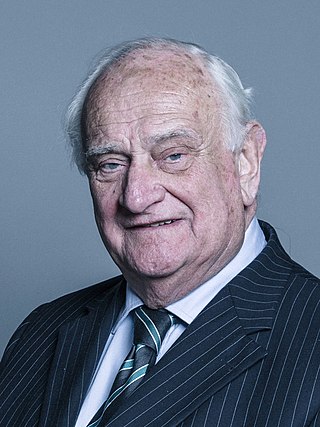
Robert Henry Alexander Eames, Baron Eames, is an Anglican bishop and life peer, who served as Primate of All Ireland and Archbishop of Armagh from 1986 to 2006.

Farnborough is a village and civil parish in West Berkshire, about 4 miles (6.4 km) south of Wantage. The village is 720 feet (220 m) above sea level on a ridge aligned east – west in the Berkshire Downs. It is the highest village in Berkshire.

Adlestrop is a village and civil parish in the Cotswolds, 3 miles (5 km) east of Stow-on-the-Wold, Gloucestershire, England, on the county boundary with Oxfordshire. The River Evenlode forms the southwest boundary of the parish. The village is on a stream that flows southwest to join the river.

The Cathedral Church of St. Colman, usually known as Cobh Cathedral, or previously Queenstown Cathedral, is a single-spire cathedral in Cobh, Ireland. It is a Roman Catholic cathedral and was completed in 1919. Built on Cathedral Place, it overlooks Cork harbour from a prominent position, and is dedicated to Colmán of Cloyne, patron saint of the Diocese of Cloyne. It serves as the cathedral church of the diocese.
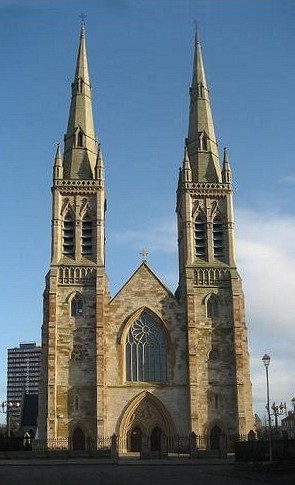
The Diocese of Down and Connor, is a Latin Church ecclesiastical territory or diocese of the Catholic Church in Northern Ireland. It is one of eight suffragan dioceses in the ecclesiastical province of the metropolitan Archdiocese of Armagh. Bishop Alan McGuckian is Bishop.
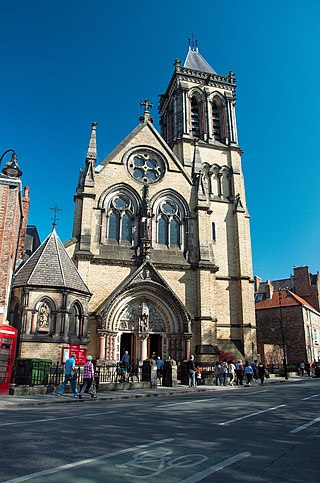
The Oratory Church of Saint Wilfrid, York is a Catholic church in York, England.

The Diocese of Connor is in the Province of Armagh of the Church of Ireland.

John Baptist Crozier was a Church of Ireland bishop. He served as Bishop of Ossory, Ferns and Leighlin (1897–1907), Bishop of Down, Connor and Dromore (1907–1911), Primate of All Ireland and Archbishop of Armagh (1911–1920).
Arthur William Barton was a Church of Ireland clergyman, from 1939 Archbishop of Dublin.
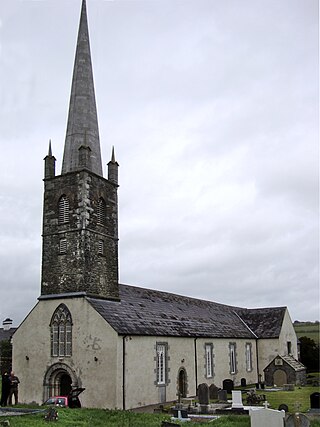
The Cathedral Church of St. Fachtna, also known as the Cathedral Church of St Faughan,Ross Cathedral, and Rosscarbery Cathedral, is a cathedral of the Church of Ireland in Rosscarbery, County Cork in Ireland. Located in the ecclesiastical province of Dublin, it is the smallest cathedral in Ireland. Having once been the mother church of the Diocese of Ross, it is now one of three Anglican cathedrals in the United Dioceses of Cork, Cloyne and Ross, alongside Saint Fin Barre's Cathedral and Cloyne Cathedral.

Great Haseley is a village and civil parish in South Oxfordshire, England. The village is about 4.5 miles (7 km) southwest of Thame. The parish includes the hamlets of Latchford, Little Haseley and North Weston and the house, chapel and park of Rycote. The parish stretches 6 miles (10 km) along a northeast — southwest axis, bounded by the River Thame in the north, Haseley Brook in the south and partly by a boundary hedge with Little Milton parish in the west. The 2011 Census recorded a parish population of 511.
Cuthbert Irvine Peacocke TD was the 8th Bishop of Derry and Raphoe, retiring in 1975.

St Oswald's Church is in the village of Warton, Lancashire, England. It is an active Anglican parish church in the deanery of Tunstall, the archdeaconry of Lancaster, and the diocese of Blackburn. Its benefice is united with those of St Mary, Borwick and St John the Evangelist, Yealand Conyers. The church is recorded in the National Heritage List for England as a designated Grade II listed building. The ruined remains of the medieval rectory survive next to the present vicarage to the west of the church.
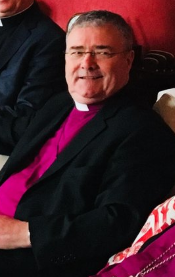
Francis John McDowell is an Anglican bishop, who is the current Church of Ireland Archbishop of Armagh and Primate of All Ireland.
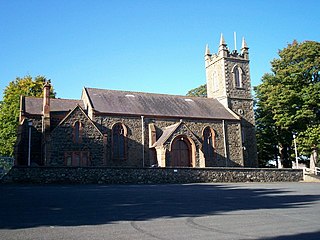
Seagoe parish or St Gobhan's parish is an ecclesiastical parish of the Church of Ireland that is located in Portadown, County Armagh, Northern Ireland. It is on one of the oldest recorded sites of Christianity in Ireland. Christian links to the area date back to the early 500 AD's. It was founded by St. Gobhan.
John Murphy was an Irish bellfounder. His foundry, which started making bells in 1843, cast bells for many churches in Ireland and elsewhere, including several rings of bells hung for change ringing.
























